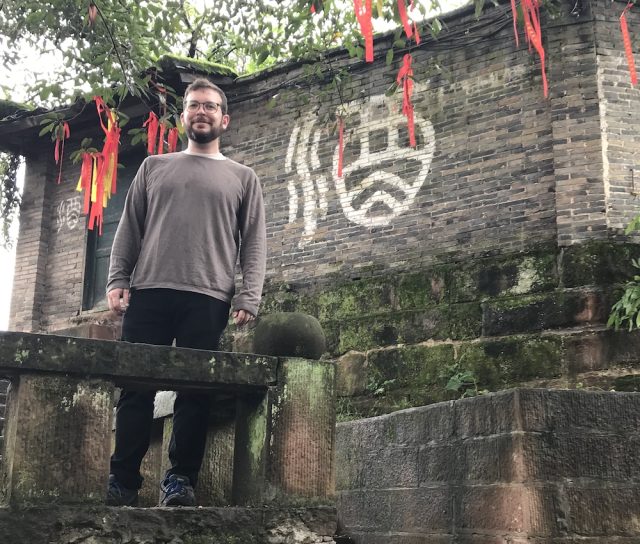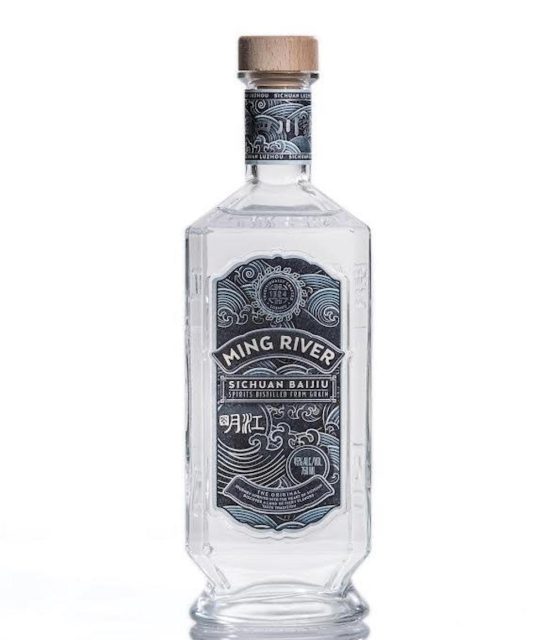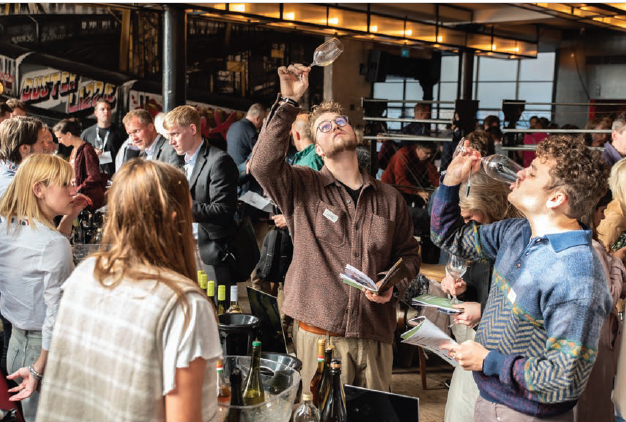Meet The Maker: Derek Sandhaus, Ming River Baijiu
With a mission to “Bring baijiu from China to the world”, Ming River is crafted at Luzhou Laojiao in Sichuan province. It was developed by baijiu expert Derek Sandhaus and the founders of Capital Spirits in 2018. Sandhaus talks to Douglas Blyde about the “vast, and vastly rewarding category” that is baijiu.

Is Baijiu your day job?
Days, nights, weekends. My dog’s not putting herself through college…
What is Baijiu?
Baijiu, literally “white spirits” in Mandarin, is a category of at least a dozen traditional Chinese grain spirits. Baijiu styles are regional in origin, and differ greatly in terms of aesthetic qualities and production techniques. Most baijiu, though not all, are distilled from sorghum. What all baijius have in common is that fermentation is conducted using cultures of wild yeast and other microorganisms know as qu (pronounced “chew”), and that fermentation and distillation are performed in a solid or semi-solid state. Most modern baijiu is aged in a neutral surface like terracotta clay and blended for consistency and proof before bottling.
How did you discover it?
I first encountered baijiu while living in Shanghai almost twenty years ago. Little ritual was involved at the time, as a fellow expat surprised us with it at a house party and we all reacted with various degrees of dismay. It was very strong, and didn’t taste like anything I was used to drinking at the time. Later encounters, mostly at business meetings and weddings, were similarly negative, because the consumption method was a socially charged binge-drinking session, and I couldn’t keep up. I just found the whole experience baffling.
Why did you persevere?
I persevered precisely because I was baffled. I saw the ubiquity of the drink in China and how much the people there relished drinking it, and I correctly intuited that there must be something – quite a few things it turned out – that I was missing. The problem with my early encounters with baijiu is that they unfolded in a state of complete ignorance. I didn’t know what baijiu was, what it was made from, how it was made, what it was supposed to taste like, why people drank it the way they did. I didn’t know anything. When I took the time to understand baijiu, its production, history, and the cultural context behind it, that’s when things clicked for me. Baijiu wasn’t that strange drink I tried a handful of times, it was a world of drinks, each with its own special characteristics and flavour profile. It was a vast, and vastly rewarding, category. The more I tasted, the more I found to recommend it, and the more I realised how much I had been missing.

How much Baijiu is consumed in China, and why should the West take the time to discover it?
So much baijiu; quantities so vast they challenge our ability to process them. To paraphrase Stalin, one litre of baijiu is a good night out, but a billion litres is a statistic. And China produces and consumes more than seven billion litres a year. That’s also why those living outside of China should take the time to better understand it. It’s by far the most widely consumed distilled spirit on the planet. There are single styles of baijiu that dwarf the annual production figures of the second-most-consumed spirit, vodka. If you want to be a knowledgeable consumer of spirits, you’re cheating yourself if you skip baijiu. The volume of baijiu produced and consumed in China also speaks to its cultural significance, which spills over into most areas of life in China—so it’s impossible to fully understand China, as influential a nation as any on the planet, without understanding something about baijiu and the local drinking customs. Finally, and perhaps most important, baijiu can be quite good, and is an incredibly diverse family of spirits. If you find one you like, there are dozens or hundreds more to sip and savour. It’s as rewarding a category to explore as any out there.
Is it akin to vodka, single malt whisky, mezcal, all three, or none of these?
Yes and no. With baijiu you’re dealing not with one but many spirits, so while you can find similarities between individual styles and their global counterparts, you can’t generalise much. Strong-aroma baijiu, for example, has similarities to high-ester rums, especially in a cocktail. Rice-aroma baijiu is almost indistinguishable from a Japanese awamori, though also not so different from vodka. Some light-aroma baijius have the smokiness one associates with mezcal. But since baijiu is never aged in oak, it probably doesn’t readily have a parallel with most aged Western spirits.
When, and with whom, did you decide to create Ming River?
I started Ming River with the team behind Capital Spirits Baijiu Bar in Beijing, and Bill Isler and Matthias Heger are part of the current team. I met them when I was giving a talk about baijiu in Beijing in 2014, which became their inspiration for creating the bar and our eventual decision to work together a couple years later.
How did you appoint the distillery partner?
It was really the other way around. We were introduced to the management of the Luzhou Laojiao Distillery by a mutual friend, and learned that they had been interested in creating a baijiu for the international mainstream market for some time. They knew how to make amazing baijiu, but didn’t feel like they had the right team in-house to successfully sell and market it overseas. The partnership made too much sense, so we agreed to work together on creating a brand, and launched it two years later in 2018 in New York and Berlin.
Is Ming River made in the traditional way?
It is. The Ming River blend is unique to the brand, but all the baijiu that goes into it comes from the same processes Luzhou Laojiao has been employing since 1573. As the oldest continuously operating strong-aroma baijiu distillery, Luzhou Laojiao pioneered two of the style’s defining techniques: mud pit fermentation and continuous mashing, or what they call the “thousand year pit, ten thousand year mash.” It works like this. Distillers mix steamed sorghum with qu to kick off fermentation, then bury the solid mash in subterranean pits for two-to-three months. These pits are large, holding about 20-30 tonnes of mash, and are lined and sealed with river clay. At the end of the fermentation period, the seal is broken and the mash is removed and distilled a layer at a time. The top layer is the driest and least flavourful, so it is distilled and discarded, whereas the bottom layers (roughly 80% of the mash) are mixed with fresh sorghum and distilled. The Chinese still runs steam through the solid mash, so as the fermented mash is distilled, the freshly added sorghum is steamed and creates a fresh starch source for fermentation. Following distillation/steaming, the distiller removes the mash, cools it on the distillery floor, and adds more qu to kick off the next round of fermentation, then buries it back in the same pit to start the process anew. This process continues indefinitely over months, years, decades, centuries…
What happens next during this process?
Partner Content
First, the river clay that lines the pit absorbs the microorganisms and chemicals from the fermentation process, and over time becomes part of that fermentation process. The longer a pit is in continuous use, the more stable the fermentation becomes, and the greater the depth of complexity in the resulting baijiu. It takes thirty years for a pit to reach full maturity, hence the name of our distillery, Luzhou Laojiao (Luzhou Old Pit). Second, the mash is constantly being refreshed with new grain while maintaining its essence over time. It’s like a sourdough starter where you are constantly feeding it fresh grain to maintain its viability over time. The pit and the mash are symbiotic elements of a unified system.
What “aroma” is it?
Strong-aroma baijiu, aka nongxiang 浓香.
How best should we enjoy Ming River?
I like my baijiu the classic way, neat alongside a heaping bowl of Sichuanese food and a beer. Many of our customers prefer it mixed in a cocktail – it works incredibly well in tropical-style and bitter drinks – of which one can find with increasing ease outside of China. Strong-aroma baijiu is designed to pair with Sichuanese food, which is incredibly spicy and features the liberal use of chilis, raw ginger and garlic, various fermented bean and pepper condiments, and of course the numbing Sichuan peppercorn. The baijiu features three distinct layers of flavour in perfect balance: fruity (pineapple, melon, guava), floral (anise, fennel), and funky (blue cheese and other umami bombs).
Does good Baijiu lead to a hangover?
Not in proper moderation, but if you believe in yourself…
What are your hopes for Ming River in the UK market?
We’ve already gained a loyal following in London and a few pockets around the country, like Bristol and Cardiff, but our hopes for the UK are the same for hopes elsewhere in the planet. We see a future in which baijiu joins the canon of international spirits – Scottish whisky, Russian vodka, Mexican tequila, Chinese baijiu – that everyone can reasonably expect to find behind the bar wherever they go. We want to lead and accelerate that change by being the first baijiu brand to successfully compete in the mainstream marketplace.
Where are you based?
I’m based in Athens, and my partners live in Los Angeles, Berlin and New York. We don’t oversee the blending, as Luzhou Laojiao employs some of the best blenders in the baijiu business. We helped them develop and test their blend, but we trust them implicitly to maintain consistency over time and they do a marvellous job at it.
How have you been described in China as a Westerner creating an Eastern drinks brand?
That would be an accurate description, of course, but I’m not creating it in isolation. Our team overseas can be counted on one hand, the distillery in China that drives the project has a team of thousands. We all love baijiu and that’s what unites us. That said, while operating outside of China, we believe there’s a responsibility to approach our work with respect, and to provide our customers with accurate information that gives proper credit to the drink and the people who make it.
Can Baijiu act as a cultural and diplomatic bridge between East and West?
It’s just a drink, but anything that brings people together and facilitates conversation can’t hurt. My interest in baijiu grew out of a desire to participate more fully in the social life of China while I was living there, and I was rewarded with a number of meaningful friendships along the way. A wider international appreciation of baijiu could create more opportunities for cultural exchange. It isn’t the only way to bring people together, but it helps.
What awards are you most proud to have garnered for Ming River?
We’ve won a number of gold medals at reputable spirits competitions like the San Francisco World Wine and Spirits Competition and even picked up a Trophy at the International Spirits Competition a few years ago, but at the risk of sounding corny, I’m most proud of the positive feedback we’ve gotten from seasoned baijiu drinkers. The approval of people who grew up and around baijiu means so much more than any international spirits accolade.
What books have you written?
I’ve published five books about Chinese history and culture, the most recent two Drunk in China and Baijiu: The Essential Guide to Chinese Spirits are more narrowly focused on Chinese drinks and drinking culture. There’s definitely more in the pipeline, though I’m still in the research phase so I don’t want to say too much. Suffice it to say that I’m turning my attention closer to home in the eastern Mediterranean.
Who, from history, would you wish to savour Ming River with?
Of the historical figures I met in my China research, the one to whom I keep returning is Tao Yuanming. He was a poet-official who lived in China almost seventeen hundred years ago, during a period of relative decline and instability, and he wrote a magnificent collection of poems about life and drinking. He approached his work with tenderness, restraint and humour, and those are cherished qualities in a drinking partner.
Related news
Wine List of Week: The Ragged Robin




